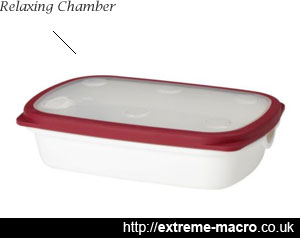Relaxing Insects
by Johan J Ingles-Le Nobel
Last updated August 31, 2017
While insects should be photographed or mounted on the same day they were collected, this is not always possible.
Once the insect has dried out, you'll need to use a technique known as 'relaxing' to loosen its limbs to be able to set them in their proper position again. Relaxing, as the name suggests, just relaxes a hardened insect and it is a stage in insect preparation prior to carding the insects and pinning the insects, but usually the insect cleaning has already been done by this stage.

Ikea fridge box, which I use as a relaxing chamber. Almost anything that's airtight will do, as long as you can get the lid on and off fairly easily and it's deep enough to take a rag soaked with the relaxing fluid. Airtight is mandatory; see-through and stackable are bonuses.
Successful Relaxing
Various chemicals can be used to relax an insect but the principle is generally the same - a chamber either with high moisture and some chemical added to prevent mould.
I personally use a basic tupperware chamber that I can close off and lie insects on top of smooth paper, on top of a small rag sopping with a relaxing agent. It usually takes 48 hrs or so to relax a specimen and I usually leave the closed box sitting on top of my PC or radiator to keep it warm and encourage moisture. I have the specimens on a 5x5 cm piece of smooth, non-ragging paper, so that no fibres come off the paper, and so that I can lift the paper up using tweezers and look at them under a stereo microscope to judge if they're ready.
All sorts of relaxing agents can be used and bought on the Internet but I tend to just use acetic acid (pickling vinegar in the UK) because it is cheap and doesn't stink as bad as some of the other ones I've tried, ie the proper Watkins & Doncaster relaxing agent (which honks of formaldehyde).
Acetic acid has a mild acid smell and you can leave specimens in there for a long time without ill effects. I also add a moth ball or two to make sure there's no mould. They will darken when moist though.
You can also use plain hot water but this may cause staining and eyes to discolour - although eyes can be restored using Decon90.
An old vegetable steamer can also be employed to relax beetles, with a recommended time of 10 minutes in the steamer for beetles.
Relaxing Stiff Specimens
Acetic acid works quite well, but where the proteins of the muscles have become hard due to denaturation, acetic acid will not relax specimens. In such cases, a chemical is needed which will break down the proteins. In Germany they use simulated gastric juice for this: 1% pepsin, 1% hydrochloric acid and 98% water. More time is needed for larger beetles, or at lower temperatures.
Specimen Preparation Walkthrough
1 ➤ The specimen preparation workflow
2 ➤ How to clean preserved specimens
3 ➤ How to relax specimens for spreading
4 ➤ How to make spread specimens for setting
5 ➤ How to cure dehydrated eyes
6 ➤ How to dry a cured specimen fast
7a ➤ How to pin a cured specimen, or...
7b ➤ How to card a cured specimen
Other reading: focus stacking walkthrough
Powder Pepsin can be bought from chemical traders in the UK but needs to be activated by a very low pH value ie mixing it into HCl (hydrochloric acid). At the present time it is possible to buy powder pepsin and HCl from timstar in the UK.
A long time ago a Japanese entomologist published in the AES bulletin that you could use the proteolytic enzyme in fig juice to relax insects. I have no confirmation of this.
Relaxing A Leg
Sometimes you want to just relax part of the specimen. Barber's Fluid, Household Ammonia, Gin can all be used in single drops to relax individual anatomy parts such as legs, antennae etc.
Why Do Dead Insects Cross Their Legs?
Insects have soft cuticles, which are pliable because of their water content. When an insect dies, water stops being supplied in the body to this cuticle, which immediately contracts, flexing insects into a cross-legged position. On top of that, insect flexor muscles that bend the limb are almost always bigger and stronger than extensor muscles that straighten it, and in death the flexors win out.
Why Are Dead Things Stiff?
It's all to do with calcium. In a living animal, when calcium enters muscle, the muscle contracts. In order for the muscle to relax, the fibres have to use energy to get rid of the calcium. So it takes energy to relax your muscles as well as to contract them. When something dies, muscle cells stop receiving the chemicals that they get energy from. Calcium is in the muscle fibres but they have no energy to get rid of it with, so the muscles can't relax and all the joints in the body stay rigid.
Related Articles




